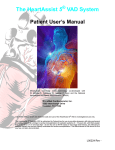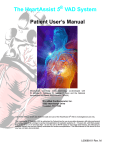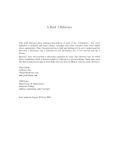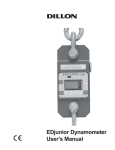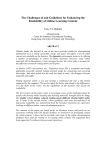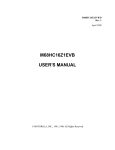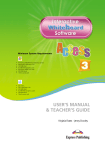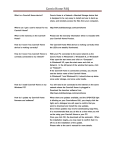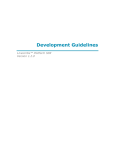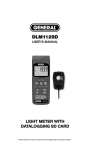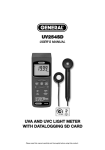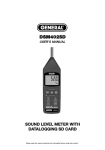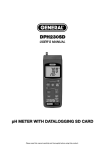Download Proposal for Reorganization of the Patient Users Manual
Transcript
PO Box 1207 Alvin, TX 77512 281-543-5195 Proposal for the Reorganization of The HeartAssist 5® VAD System Patient User’s Manual OVERVIEW The HeartAssist 5® VAD Patient User’s Manual is a guide for patients implanted with the HeartAssist 5® VAD heart pump and those patients’ caregivers. The manual is designed to be read in its entirety before using the HeartAssist 5® VAD and to be used as a reference during use. A complementary operator’s manual exists for the use of medical personnel. REQUIREMENTS The HeartAssist 5® VAD Patient User’s Manual has many authors and reviewers and must comply with ISO 9001, EN, and other standards. A current copy of these guidelines and any accompanying materials (such as graphic files) should be supplied to Farrell Documentation before reorganization commences to ensure compliance. Note: This document uses the word “Chapter” to refer to what are now called “Sections” in the book. The word “section” refers to the part of the document consisting of second-level headings (under a chapter title) and the text, tables, graphics, and subheadings under that heading. The word “subsection” refers to the third- and fourth-level subheadings, text, tables, and graphics that fall under second-level headings. “Part” refers to a group of chapters that combine to convey a particular meaning. ADDITION OF POINTERS I recommend the following additions or changes to the manual, to serve as pointers, to guide users to information. • Parts (See Reorganization: General Recommendations, page 2 or the outline at the end of this document.) • Index 1 • Scope 2 • Requirements for Use 3 • Terms and definitions 4 1 A proper index is essential for finding information in a complex manual. It is a user-centric pointing device that is often the first place a reader will look when searching for information. 2 Required by BS EN 1041. This addition can be a subsection, such as a paragraph or two in the Overview. (This information already appears in the introduction in 2.0 and can be repurposed for this chapter.) 3 Required by BS EN 1041. This information is already in the manual, but it is distributed throughout the book. The information dispersed throughout does not necessarily have to be removed and placed in a new section, but it should be consolidated so that readers can quickly identify what is required to operate the unit. Much of the information is in “Environmental Conditions.” Other information appears in “General Considerations” and other places throughout the book. 4 Required by BS EN 1041. This chapter is to include device nomenclature and common terms. www.farrelldoc.com [email protected] 866-229-0121 (fax) Karen Farrell Page 2 • How to use this manual 1 REORGANIZATION I recommend the following changes to the manual to assist in the organization and increase comprehension and retention. See the outline at the end of this document for further clarification and a preview of the reorganized manual. GENERAL RECOMMENDATIONS • • • Rename the Sections as Chapters. In technical documentation, section is the term used for groups of chapters or subdivisions within chapters, not the chapters themselves. This book would also benefit from the use of “parts” for further organization. For example, Chapter 1 through Chapter 3 would be Part 1, “Becoming Familiar with your HeartAssist 5® VAD System.” (You also keep the chapter numbers and titles.) Chapters 4 – 6, Chapters 9 – 12 and Chapter 14 would be Part 2, “Managing your HeartAssist 5® VAD System.” Part 3, “Quick Reference and Troubleshooting” would consist of Chapter 7, Chapter 8, and Chapter 13. Use parallel headings throughout the book, or at least in each chapter, for each heading level. For example, in Chapter 10, Begin each Level 2 heading (the level under the chapter title) with either a noun or a gerund. This practice is shown to increase readability and comprehension in usability studies. It keeps the reader from stumbling and re-reading. GENERAL WARNINGS AND PRECAUTIONS • • Insert introductory text after the chapter title that includes definitions of warnings and cautions. The standard meaning in technical documentation is that a warning indicates the possibility of serious bodily injury or death and a caution indicates the possibility of equipment damage. A note provides important information that does not pertain to damage or injury. A hint provides information or shortcuts that assist the reader. (In other manuals, such as software manuals, the meanings are slightly altered to mean irreparable damage to equipment or total data failure for warnings and software or hardware errors for cautions, but the definitions should be clearly defined in any case.) Remove the numbering from the warnings and cautions. Numbers indicate a sequence. CHAPTER 1, “OVERVIEW” • • • 1 Repurpose the existing information in the current Overview chapter as an “FAQ” section of a redesigned Overview chapter. Move Chapter 2.0, “Introduction to the HeartAssist 5® VAD” into the Overview as the first section. Add the “How to Use this Manual” and “Scope” sections. This section is standard in technical documentation and includes an explanation of terms and pointers specific to the book. It explains the difference between a Note, a Caution, and a Warning, for example. It defines who should read the book and points others to the proper book for them. This addition can be a section of the Overview chapter. Karen Farrell Page 3 CHAPTER 2, “INTRODUCTION TO THE HEARTASSIST 5® VAD” • • • • • This chapter will be moved into Chapter 1 “Overview” as the first section. Leave the first paragraph as is. The second paragraph will become the new Scope section in Chapter 1, “Overview.” Create an Overview subheading for the third paragraph. Remove the word “The” from the subheadings. CHAPTER 3, DESCRIPTION OF THE HEARTASSIST 5® VAD SYSTEM • Change subsection 3.1 “The HeartAssist 5® VAD System” to “Overview.” This subsection is an • • overview of the system while the other subsections detail the specific components. The current subsection title too closely resembles the chapter title. Leave the content in the subsection as is. Include brief introductory text to appear before Figure 3-1. Remove the word “The” from the headings that contain the word. CHAPTER 5, “CONNECTING YOUR CONTROLLER TO THE VADPAK OR HEARTATTENDANT®” This chapter currently has four essential parts. The first part details general considerations and an overview of how the HeartAttendant® and Controller (and to some extent the VADPAK) work together and who programs them. The second part details how to manage batteries; the third part details how to manage the VADPAK, and the fourth part details how to replace the Controller. Based on this information, I recommend the following: • Rename this chapter “Getting Started with your HeartAssist 5® VAD System” because this chapter contains more information than just connecting the Controller. Most user manuals contain a “Getting Started” chapter, and this usage makes users comfortable. • Add an Overview section at the beginning. This overview coincides with the first “part” mentioned in the paragraph above. • Make a “Requirements for Use” subsection in the overview and move 5.1 “General Considerations” there as a subsection. Add another subsection titled “Power Requirements.” • Make the current Sections 5.1 – 5.3 subsections of the Overview section of this chapter. • Section 5.3, “Controller”: Create subheadings with existing information: “Alarms” and “Memory.” • Move the first part of 5.4, “Batteries” (the introductory material) into the overview section of the chapter, and make the subsections 5.4.1 – 5.4.3 into a section titled “Managing your Batteries.” • Move the first part of section 5.5 “VADPAK” into the overview. • Rename section 5.6, “Controller Replacement” to “Replacing the Controller” for parallelism. • Move subsection 5.5.1 “To Manage the VADPAK” up a level, even with “Replacing the Controller,” and retitle it “Managing your VADPAK.” CHAPTER 6, “HEARTATTENDANT®” Section 6.5 is titled “Hazards” and has a single subsection, 6.5.1 “Grounding.” Subsection 6.5.1.1 refers to warnings that are present on the HeartAttendant® labeling, but the warnings are not found in the document in this location. Section 6.5 does say that the HeartAttendant® must be connected to protective earth ground and configured for local mains voltage, but those are not hazards as listed; grounding is a requirement; the consequence for plugging in the device in a non-grounded outlet is not listed here. Karen Farrell Page 4 Subsection 6.5.1.1 describes plugging the HeartAttendant® into an electrical outlet. I suggest that the whole of section 6.5 be combined with section 6.1, “Connecting to the Power Source” and the section and subsection headings be reordered. (For example: 6.1, “Connecting to a Power Source,” 6.1.1 “Grounding,” and 6.1.2 “Mains Voltage Cord, Mains Voltage Range and Fuses.” (See the outline at the end of the document for clarification.) CHAPTER 8, “SUMMARY OF USE” • Retitle Chapter 8 to “Alarm Quick Reference” from “Summary of Use” and remove the words “Quick Reference” from the subheads. This title more accurately summarizes the contents of the chapter. CHAPTER 9, “DAILY CHECKS” • • Combine the “Daily Checks,” “Daily Operation,” and “Self-Care” chapters into one chapter named “Everyday Use and Self Care.” This chapter will become a section titled “Daily Checks Using the HeartAttendant” in the new “Everyday Use and Self Care” chapter. It will have two subsections: “Before you go to Sleep” and “When you first Wake in the Morning.” CHAPTER 10, “DAILY OPERATION” • • • • This chapter will become the bulk of the “Everyday Use and Self Care” chapter. Swap the order of subsections 10.2, “To Switch from Untethered to Tethered Operation” and 10.3, “Untethered Operation.” As it is now, the book introduces the process to switch between operation types before it introduces the second operation type. Combine Section 10.6, “Bathing” (which only contains two cautions and one sentence) and Section 10.7 “Using the VADPAK and Shower Bag” (which contains instructions for showering). Move 10.9 “No Known Risk” under section 10.8 “Activity Restrictions”, which contains two tables with the headings “Absolutely NO” and “Consult Your Doctor Regarding.” In this section, add another table with the heading “No Known Risk” and insert the moved content to that table. CHAPTER 11, “SELF-CARE” • • The “Self-Care” chapter will become a section in the new “Everyday Use and Care” chapter with two subsections: “Exit Site” and “Medications.” Move Section 11.1.2, “VADPAK” to a new subsection 2.5 as part of the “Introduction to the HeartAssist 5 VAD System.” This text simply describes the VADPAK and is not about self care. There is currently no description of the VADPAK in the introduction. CHAPTER 12, “EQUIPMENT CARE AND MAINTENANCE” • • • Provide an introduction before 12.1. Consider a section for VADPAK maintenance. Remove stacked head for 12.4.1 “HeartAttendant.” CHAPTER 14, “THE PEDIATRIC PATIENT ON HEARTASSIST 5 PEDIATRIC VAD SUPPORT” • Include a graphic of a pediatric unit. Karen Farrell Page 5 COSMETIC SUGGESTIONS A serif font for the main body text (all but headings, titles, and callouts) would increase the readability of the document. Sans serif fonts are generally used for online documentation and headings in hardcopy documentation, and serif fonts are most often used for hardcopy materials, especially lengthy documents such as books. According to usability studies, the serifs make it easier for the eye to follow the words across the page. Alignment of the callout arrows (such as in Figure 3.3) would provide more deliberate look for the manual. A further enhancement would be to replace the yellow arrows with a dotted line. Comprehension would be retained (readers would still understand that the callout was pointing to that particular area of the graphic), but the book would have a more modern look and feel. An example of how the replacement would appear as follows: Current callout style Three proposed callout style options In the second figure, there are three examples of how the lines could be formed. It may be difficult to discern the differences between the three styles in the reduced-size graphic shown above, but the top line is dotted, the left lines solid, and the right lines are dashed. A full-size example follows. Lines can be adjusted to any point size. The current point size used in the lines above is 2.0 pts. Karen Farrell Page 6 PREVIEW OF NEW ORGANIZATION The following outline displays the proposed structure of the reorganized HeartAssist 5® VAD Patient User’s Manual. The HeartAssist 5® VAD System Patient User’s Manual Emergency Information Contents Figures General Warning and Precautions PART 1, “BECOMING FAMILIAR WITH YOUR HEARTASSIST 5® VAD SYSTEM” 1. Overview 1.1. Introduction to the HeartAssist 5® VAD 1.1.1.The Pump System 1.1.2.The Controller 1.1.3.The HeartAttendant Console 1.2. How to Use this Manual Karen Farrell 1.3. Scope 1.4. FAQ 2. Description of the HeartAssist 5® VAD System 2.1. Overview 2.2. Pump 2.3. Controller 2.4. HeartAttendant® Console 2.5. VADPAK 2.6. VADPAK Shower Bag PART 2, “MANAGING YOUR HEARTASSIST 5® VAD SYSTEM” 3. Environmental Conditions 3.1. Temperature Conditions 3.2. Contact with Liquids 3.3. Electromagnetic Interference 4. Getting Started with your HeartAssist 5 VAD System 4.1. Overview 4.1.1.Requirements for Use 4.1.1.1. General Considerations 4.1.1.2. Power Requirements 4.1.2.HeartAttendant Console 4.1.3.Controller 4.1.3.1. Alarms 4.1.3.2. Memory 4.1.4.Batteries 4.1.5.VADPAK 4.2. Managing your Batteries 4.2.1.Connecting a Battery Cable to the Battery Port 4.2.2.Battery Indicators on the Controller 4.2.3.Changing a Battery in the VADPAK 4.3. Managing your VADPAK 4.4. Replacing the Controller 5. HeartAttendant 5.1. Connecting to the Power Source 5.1.1.Grounding 5.1.2.Mains Voltage Cord, Mains Voltage Range, and Fuses 5.2. Using the Heart Attendant as a Power Source 5.3. Recharging Batteries 5.4. Description of Screens 5.4.1.Displays Common to all HeartAttendant Screens 5.4.2.Patient Display Screens 5.4.3.Sleep Mode 5.4.4.Battery Display Screen Page 7 Karen Farrell Page 8 6. Everyday Use and Self Care 6.1. Daily Checks using the HeartAttendant 6.1.1.Before you go to Sleep 6.1.2.When you First Wake in the Morning 6.2. Daily Operation 6.2.1.Tethered Operation 6.2.2.Untethered Operation 6.2.3.Switching from Untethered to Tethered Operation 6.2.3.1. Be sure that the HeartAttendant is ready to be used 6.2.3.2. Connect the HeartAttendant Interface Cable to the External Interface Port 6.2.4.Switching from Tethered to Untethered Operation 6.2.4.1. Before Disconnecting from the HeartAttendant 6.2.4.2. Disconnecting the VADPAK from the HeartAttendant 6.2.5.When Away from the Residence 6.2.6.Showering with the VADPAK and Shower Bag 6.2.7.Activity Restrictions 6.3. Self Care 6.3.1.Exit Site 6.3.2.Medications 7. The Pediatric Patient on HeartAssist 5 Pediatric VAD Support 7.1. Implant Surgery 7.2. Description 7.3. Environmental Conditions 7.3.1.Temperature 7.3.2.Contact with Liquids 7.3.3.Electromagnetic Interference 7.3.4.Electrostatic Discharge 7.4. Operating the HeartAssist 5 Pediatric VAD System 7.5. Daily Operation 7.5.1.Leaving your House 7.5.2.Return to School 7.5.3.Activities 7.5.4.Bedtime 7.5.5.Bathing 7.6. Emergencies 8. Equipment Care and Maintenance 8.1. Controller 8.2. HeartAttendant 8.3. Warranty and Service 8.4. Voltage Selector and Settings Karen Farrell PART 3, “QUICK REFERENCE AND T ROUBLESHOOTING” 9. The Controller: Front Panel Display, Alarms, and Troubleshooting 9.1. Standard Messages (Seven Scrolled Information Screens) 9.2. Alarms 9.2.1.Emergency Alarms 9.2.2.Diagnostic Alarms 9.2.3.Fail-Safe Alarms 9.2.4.Controller Failure Alarm 10. Alarm Quick Reference 10.1. Controller Alarms 10.2. HeartAttendant Alarms 10.2.1. Emergency Alarm: Red Flashing Bar 10.2.2. Diagnostic Alarm: Yellow Flashing Bar 11. Emergency Response and Troubleshooting 11.1. Emergency Response 11.2. Troubleshooting 11.2.1. Non Pump-Related Problems 11.2.2. VADPAK Problems 11.2.3. HeartAttendant Problems Index Page 9









